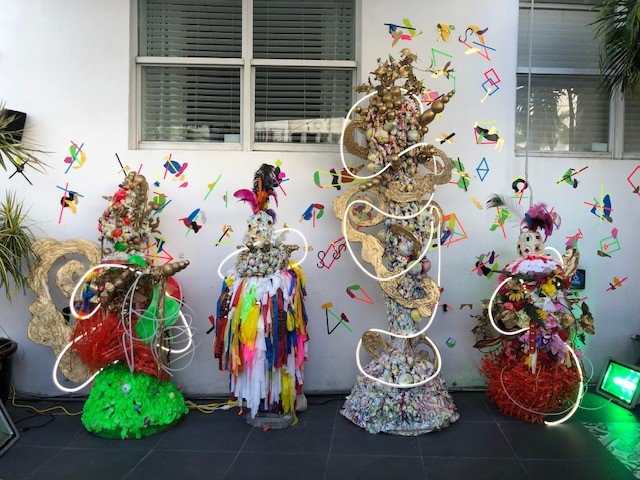Catalina Hotel & Beach Club, 1732 Collins Avenue, Miami Beach, FL 33139

MAXI, which comes from the word Maximalism, refers to spectacle in fashion. Its beauty lies in excess and eclecticism. Throughout history, Maximalism in fashion is often used in terms of audacious, intricate aesthetics or exaggerated silhouettes associated with extravagance and style. It relates to Baroque art with its grandeur, drama, movement, richness, and emotional exuberance. Colossally huge and disarmingly bright, Oquet’s sculptural installations transform the simple, everyday materials of concrete, plaster, wood, and fabric into durable yet ephemeral-looking, structures. With the rough, gritty appeal of a construction site, these riotous setups are decidedly anti-monument, reflecting the chaos and instability that encircles contemporary life through color and shape. The sculptures will celebrate a diverse range of approaches by the BIPOC gaze in an exhibition that combines practices from the arts and fashion to question traditional notions of Eurocentric fashion. MAXI will examine fashion from the Afro-Indigenous point of view, using radical imagination to recontextualize dress and adornment. By changing the gaze, clothing and decoration become not a means of domination and control but a tool of empowerment and joyful rebellion. MAXI will include photography, video, and ceramic sculptures. The work “sheds light on the manner in which personal and collective identities might transform, renew and adapt depending on the environments the artist constructs,” says artist Charo Oquet, “…characterized by manifold interweaving between art, design, fashion, and architecture, it addresses current discourses of global relevance.”
My 30-year practice has yielded a body of work informed by the anthropological and ethnographic gaze cast on Western society in general and Afro-Caribbean society in particular, inspired by my Afro-Dominican background. The dramatic events of the past years have made me look inward while assessing the life we are living to contemplate the future, project forward, and think about my narratives and microhistories. As an interdisciplinary artist working across visual and plastic arts, documentary, design, and performance, my images explore the fluid identity of the Afro-Caribbean diaspora. Drawing on my immigrant experience on several continents and Afro-Dominican and Taino heritage, I gather inspiration from growing up between different cultural traditions. My images are influenced by the traditional art of the Dominican Republic, and its neighbor Haiti refracted through my life in the global, hyper- modern city of Miami. MAXI synthesizes my diverse influences and practice to address questions of identity and bodily experience. Clothing affects the distance between object and viewer through materials that disrupt preconceived notions of dress. This complex world requires new non-linear, cross- thinking, and dialogue forms to open up many possibilities for innovation and bring people together. I aim to challenge assumptions of history, culture, race, and conventions of display. My work navigates across geographies, chronologies, and fields of knowledge, ranging from literature and art history, to popular music and street culture, in a loving pursuit to joyfully subvert expected figures and content. My practice centers on “Radical hope,” which demands flexibility, openness, and imaginative excellence. I have created many spaces where local artists can take risks and where artists from the margins can be seen. Much of my work resonates on both a personal and social scale, so I respond to personal intuition and autobiographical reflections in the community context. My sculptural installations are made up of tweaked everyday objects from thrift shops, the overflowing consumer world’s surplus stores, and culturally resonant materials. I transfigure these objects through appropriation and dislocation, giving this object added value. My work expands on my fascination with cultural identity, often through humor, to create a unique environment that blurs the line between art and object, the exotic and the banal, in an attempt to align the mind, body, and spirit in one space. Humor here means everything that amuses, from a joke, whimsical artwork, to using colors or materials. It can be based on irony, satire, parody, or ridicule. The humor expressed here is political, directed against oppression, and encourages critical reflection about where society is and where we want it to be.
